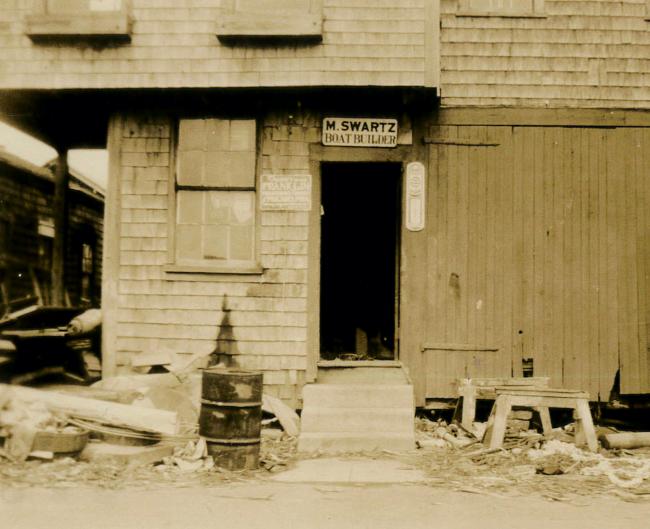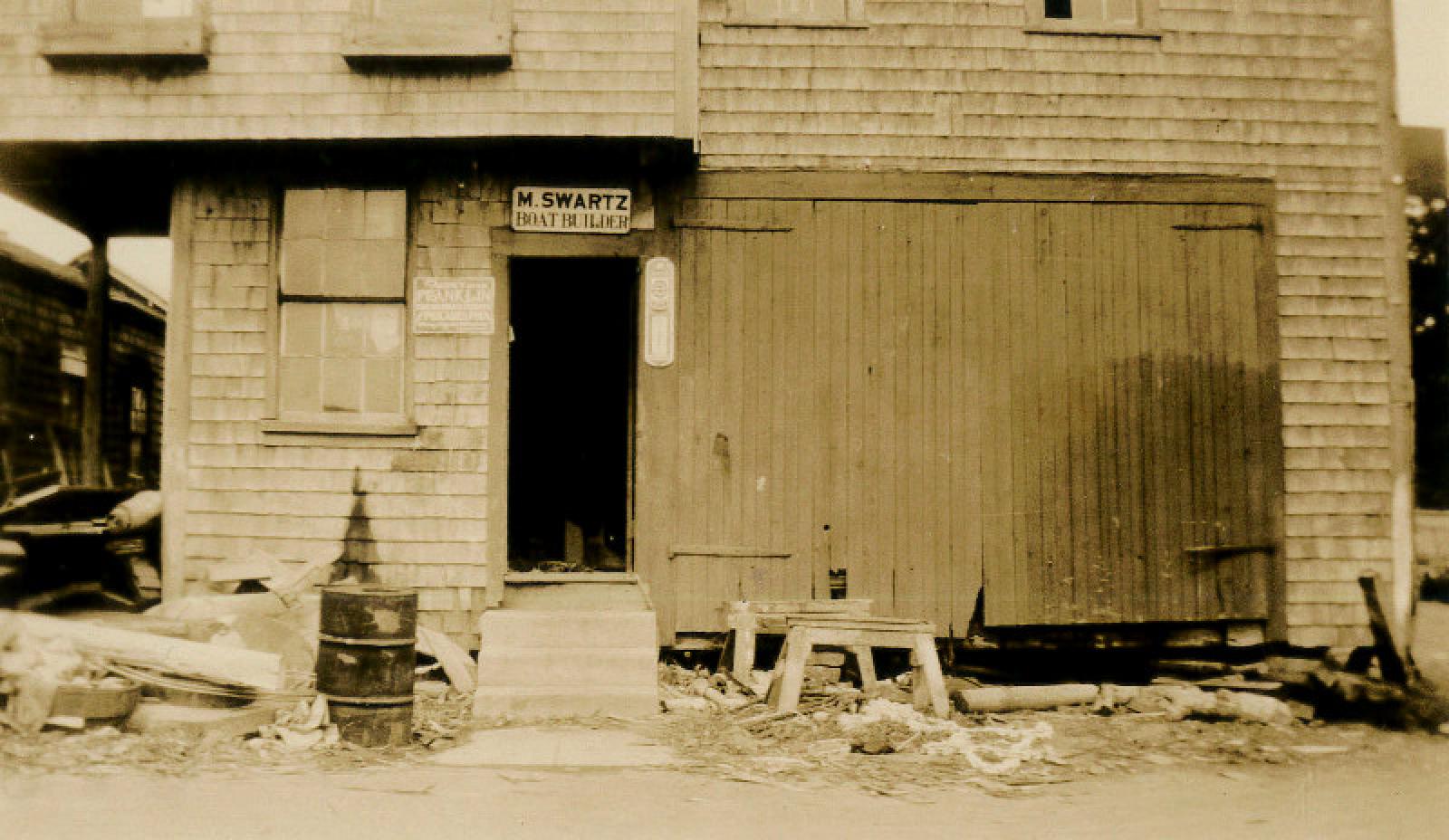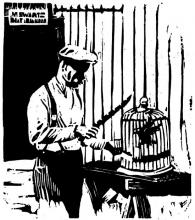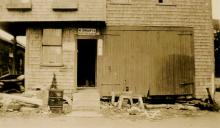There is a “For Sale” sign on the boat shop of Manuel S. Roberts at the head of the town wharf in Edgartown, a sign indicating that the historic building and the land upon which it is situated are for sale. Indicating also - and this brings a touch of near-tragedy to the picture - that this building long associated with ships, boats and salt water and men who have gone down to the sea, may enter upon a new and cheaply-gilded existence as a Gifte Shoppe - and its proprietor, as much a landmark as the building, removed from the setting which he has dominated for so long.
For the two, Manuel and his shop, belong to history, a history that is romantic, picturesque, glorious. Though Edgartown is no longer a whaling port, and even fishing vessels are seen at the piers but seldom, the atmosphere of the place still retains the flavor of ships and shipping and one of the principle ties with the past is this shop and its proprietor.
Embodies the Ancient Spirit
Manuel is one of those souls in whom the ancient spirit of the port was born. He is a man who converses in the salty expressions of sailing-ship days and who, as a boat-builder, has put into the product of his skill and craft much of himself, after the ancient usage.
Now, after nearly half a century on this spot, during which he has built and launched a mighty fleet indeed, he is considering the “shifting of his moorings” to a smaller, and more secluded place, there to carry on much as he does now, but to the distinct loss of the hundreds and perhaps thousands who visit the docks through the year and who look for him as they look for the sunrise over Chappaquiddick or the return of the racing yacht fleet.
It was in 1905 that Manuel purchased the building and moved in as a boat-builder. He was already established in the business, having had his own shop for a year or more previously. Here, however, he expanded, using the two floors, and here he has gained fame as a builder of small boats.
His Cape Cod type of catboat, closely resembling the famous Crosby cats of Osterville, dot the mooring basin today. He has no idea how many boats he has built for the list includes racing craft and rowboats of various sizes. A thirty-five-foot cat was once launched from this building, and a small tug, consigned to a steamship company operating on the African coast.
In between times, Manuel has distinguished himself as a cabinet-maker, working in rare tropical woods to a great extent in turning out articles of furniture which required the most intricate of lathe-work, inlay and meticulous joining. His top-top tables, reproductions of the colonial variety, have been in demand for years and even an expert could hardly tell the difference between these and the most antique, if he should resort to camouflage in order to produce an aged appearance.
May Find Aid Here
Manuel’s is a place where old and young, male and female, come when in need of skilled assistance. The small boys who damage toys, the housewives who break a favorite chair, the boatmen who require a new plank or an engine-part and householders of all ages who need anything form a mullioned window to the exact fitting of a piece of linoleum. In other words, Manuel’s is an institution high in the esteem of the Island and its many summer visitors.
Perhaps something of the atmosphere of the building which he owns and occupies has transmitted itself to the man through the years.
Certainly there is a strong affiliation existing between the two which indicates something more than years of association. The building, as noted, is historic and of another age. Two centuries old, at least, and very probably older, it was used as a sail-loft. It was old when it was moved off the dock by its then owner, Dr. Daniel Fisher, who died in 1876, and its age is apparent whether one views it from outside or in.
The timbering is massive and the framing is of the ancient style, with bracing and trusses and huge stay-bolts in order to eliminate posts beneath the second floor. The floors are of heavy planks, worn slick, beneath the heavy burden of sawdust and shavings, by the drawing of canvas across them when the sail-makers worked there. The wooden stairway, almost as rude as a ladder, still extends up through the scuttle to the loft, its heavy treads worn into deep furrows by the passage of thousands of climbing and descending feet. Here, in the loft, more indications of age and other uses are apparent than below. There is the butt of the heavy timber which once projected from the gable, supporting the tackles on which were hoisted and lowered the bundled sails, perhaps for a century’s time.
Almost a Grain Elevator
Dr. Fisher moved the building in order to convert it to another purpose, a storage place for grain. Actually it was almost a grain-elevator, for the entire upper story was a vast bin. The corn was landed at the dock from vessels, stored in the building and eventually hauled to the doctor’s mills in North Tisbury. But while it was stored, it required care to prevent heating and there are still auger-holes to be seen in the side of the building where fresh air was admitted in proper weather. At other times they were closed by means of carefully-fitted plugs.
There are strange things to be found among the quantities of lumber and gear, tools and other matters stored here. Against one of the loft walls stands a gate. Small, but heavy indeed, with massive bronze hinges. This gate was a part of the deck equipment of the old sailing revenue cutter, Tallapoosa, which was sunk in a collision off Edgartown long ago.
Sometimes Manuel will dig out a crude circular, printed with woodblock type. The wording might puzzle the average person of today, but it amounts to an advertisement of the first baking powder ever used on the Island, which was manufactured here. Ground bones formed the base of this “Rising Compound” which was sold under the name of Hosford.
On the tie-braces where it has lain for generations are a pump-rod and box, all of wood. The box is five inches in diameter, and the length of the shaft is such that a ship’s pump is indicated. Ship’s pumps and farm pumps were once made in Edgartown near this spot, but probably this rod and box are the only specimen of that ancient craft in existence.
Woods From the South Seas
Lumber is everywhere and many a plank and timber has history attached to it. There are woods from he South Sea Islands and from the African coast, brought home in whalers which have long since been forgotten. There are pieces of mahogany rails taken from wrecks on the ocean side of Chappaquiddick Island and cuts of native pine of such width add clear grain as have entirely vanished from the markets.
In the midst of all this is Manuel, gray, with crowsfeet caused by much laughter, at the corners of his eyes, a kindly smile and a cheerful word for everyone, working With the hundreds of tools which he employs, many of them so ancient that he knows nothing of their age, but prizes because of their excellent steel and tempering. His forty-foot bench is polished like a piano with use, but not entirely his own, for this is the seat favored above all others by the gallery which may usually be found in the shop at some time in every day. Never a scratch or gouge appears on the gassy, dark surface. Should anyone offer abuse to this bench Manuel’s good nature would vanish as the sun disappears before a black squall and everyone knows it.
And now, as it seems, all this may disappear from the familiar scene. There is a “For Sale” sign on the weathered building. There is serious consideration on the part of its owner, to retreat inshore from the waterfront of which he is such a beloved feature.
“If this happens,” said one villager, It will be the greatest upheaval the-town has ever known.”
And he was sincere. All others of the town, and countless visitors will feel the same.











Comments